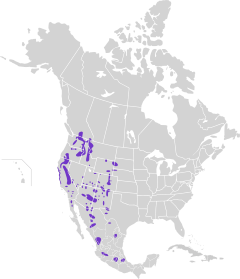Pygmy nuthatch
The pygmy nuthatch (Sitta pygmaea) is a tiny songbird, about 10 cm (4 inches) long and about 10 grams in weight. It ranges from southern British Columbia south through various discontinuous parts of the western U.S. (northwest U.S., Sierra Nevada range, southern Rockies, etc.), to central Mexico. It is usually found in pines (especially ponderosa pines), Douglas-firs, and other conifers. Pygmy nuthatches clamber acrobatically in the foliage of these trees, feeding on insects and seeds; less often they creep along limbs or the trunk like bigger nuthatches.
| Pygmy nuthatch | |
|---|---|
2_-California.jpg) | |
| California, United States | |
| Scientific classification | |
| Kingdom: | Animalia |
| Phylum: | Chordata |
| Class: | Aves |
| Order: | Passeriformes |
| Family: | Sittidae |
| Genus: | Sitta |
| Species: | S. pygmaea |
| Binomial name | |
| Sitta pygmaea Vigors, 1839 | |
 | |
Pygmy nuthatches nest in cavities in dead stubs of conifers, lining the bottom of the cavity with pine-cone scales, plant down, and other soft plant and animal materials. They may fill cracks or crevices around the entrance with fur; the function of this behavior is unknown. The female lays 4–9 eggs, which are white with fine reddish-brown spotting. She does most of the incubation, which lasts about 16 days. The young leave the nest about 22 days after hatching.
This species is highly gregarious. A nesting pair may have other birds as helpers. Outside the breeding season, this bird wanders in noisy flocks. It also roosts communally; over 100 birds have been seen huddled in a single tree cavity.
_at_a_feeder.jpg)
All plumages are similar, with a warm gray cap, blue-gray upper-parts, and whitish underparts. The only feature not seen in the photograph is a whitish spot on the nape, particularly in worn plumage (summer). Vocalizations are highly varied chirps, peeps, and chattering.
This species is very similar to the brown-headed nuthatch of the southeastern U.S. Their ranges have no overlap.
The pygmy nuthatch features prominently in the climax of the 2000 film Charlie's Angels, in which Cameron Diaz's character, Natalie, discovers the location of the villains' fortress by identifying the call of the pygmy nuthatch, which she says only live in Carmel, California—though the bird shown is not a pygmy nuthatch, which in any case is found in a much wider range. (The Hollywood impostor is a Venezuelan troupial, Icterus icterus.)
References
- BirdLife International (2012). "Sitta pygmaea". IUCN Red List of Threatened Species. 2012. Retrieved 26 November 2013.CS1 maint: ref=harv (link)
- Sibley, David (2000). The Sibley Guide to Birds. Knopf. ISBN 0-679-45122-6.
- Cassidy, James, ed. (1990). Book of North American Birds. Reader's Digest. ISBN 0-89577-351-1.
- Molinari, Matteo; Kamm, Jim (2002). Oops! Movie Mistakes That Made the Cut. Citadel Press. p. 36. Retrieved 2011-08-03.
External links
| Wikimedia Commons has media related to Sitta pygmaea. |
- Pygmy Nuthatch - Sitta pygmaea - USGS Patuxent Bird Identification InfoCenter
- Pygmy Nuthatch Species Account - Cornell Lab of Ornithology
- Photographs of Pygmy Nuthatches nesting in a box
- Pygmy Nuthatch videos on the Internet Bird Collection
- Article & RangeMaps InfoNatura, NatureServe
- Pygmy Nuthatch photo gallery VIREO
